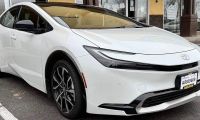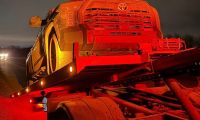The Mazda Miata and Fiat Spider are built from many of the same components on the same production line by the same workers. However, there are key differences and the engine and transmissions are the biggest two things that set these vehicles apart from one another. Although the Fiat 124 Spider Abarth has more peak power, 164 hp vs. the Miata's 155 hp, it is almost a second slower in the sprint from 0-60 MPH. Many enthusiasts prefer a normally aspirated roadster, but more power is always welcome, as long as comes with an advantage.
One advantage some turbo fans have pointed to is "power at elevation." The idea is that an engine with a built-in compressor will retain more of its usable power in the mountains, or anywhere above sea level. The theory goes that since the air is thinner, and since the turbocharger compresses the air, the turbo will do better. A new test by The Fast Lane Car (TFL Car) has just debunked that myth.
The publication tested two Miata trims vs. the 124 Spider Abarth. What makes the test interesting is that it was done at just under a one-mile elevation in Dacono Colorado. Would the Spider Abarth's turbocharger give it the extra advantage at this elevation? Not according to the runs the publication made. The Abarth was beaten by both the Miata Club and also the Miata Grand Touring. As the top of page image shows, the approximately one-second advantage the Miata has proven to have in prior tests closer to sea level holds at over 5,000 feet.
The group also timed the cars around the racetrack.Would the turbo have an advantage in that scenario? You will have to watch the video to find out. We aren't going to spoil this good story by TFL Cars.
If you think you know why the higher-power Spider Abarth can't seem to beat the Miata in a sprint, let us know in the comments below.
Related Stories:
2017 Fiat 124 Spider Abarth Faster Than Miata On Racetrack (Roadcourse)
Why the 2017 Mazda MX-5 Miata is Faster Than the Fiat 124 Spider Abarth (0-60 MPH)
2018 Fiat Spider Abarth vs. Mazda Miata RF Track Day Comparison - The Surprise Winner













Comments
To properly disprove the
Permalink
To properly disprove the greater impact of NA engines compared to forced induction engines at high altitude, they would have needed to test the cars at sea level and then at altitude. This test only proves that any difference in the impact of the thinner air isnt significant enough to make up for the general performance advantages of the Mazda. Really, performance numbers for all three cars comparing their times at sea level and at high altitude would have been far more useful than comparing three cars at high altitude.
I think the noticible turbo
Permalink
I think the noticible turbo-lag of the Fiat 1.6 is accountable for perhaps half a second (maybe more) difference 0-60 at sea-level, as boost is pulled/waste-gated on every manual-trans shift. This lag can only be exacerbated at altitude by the thinner air and lower ambient atmosperic pressure, as the turbo needs to reach a higher speed to produce as much boost (absolute air charge-density/pressure) as at sea level. A good tuner might be able to patch this up in the engine controller software without the need to switch to a turbo with a lower A/R ratio.
I see so many reports that
Permalink
I see so many reports that basically talk about the 124 turbo lag and summize the Mazda is better. For the Abarth, The source of the engines issue is not its turbo or the multi air engine. They are actually quite an amazing pair. They sadly are just delivered with some bad parts. The problem lies with a small part in the engine called the diverter valve. Rather than go for a metal part, They use a plastic part with a plastic plunger. This causes poor engagement and disengagement of the air diverter valve and leads to spotty acceleration. It also allows for air seepage as it does not seal well and also the plunger has a tendency to not close properly. The poor seal and when it doesn’t seal sends all that air elsewhere and not into the turbo which leads to the lag and poor pickup. I solved this with a part called GFB diverter valve sold online. It solves the engines lag and makes my abarth very reliable on pickup. It’s sad fca opted for such a poorly manufactured and frankly very brittle part but for turbo lovers I can’t stress enough that if you want a fast car, get the abarth 124 and spend a few dollars putting some better parts in it and you have a rocket. FCA parts are cheaper than Mazda and there are more performance upgrades that can be had for the money for this 1.4t. While it’s true you could just buy a Mazda and not buy aftermarket parts, what’s the fun in that when you end up in a car that everyone else has?
Though I agree with much of
Permalink
In reply to I see so many reports that by Mike Lang (not verified)
Though I agree with much of whatt Mike Lang has stated, the one part I do not agree with at all is cost of parts. I know of very few components that are in common between the Spider and the Miata in which the FCA's equivalent is of less cost. Typically it's the complete opposiate. Anything that's an OEM Mazda part that's rebranded as MOPAR will cost at least twice as much.
With upgarded components, many of which should have been incorporated as OEM on the Spider, and a decent tune, the Abarth will absolutely snot a Miata on the 1/4 mile, and don't even dream of a comparison on a twisty, curvy road course. The Abarth's suspension and tuning have proven over and over that iit's far superior once you enter that driving environment.
But we'll let the Miata fanboyz live their dream. :-)